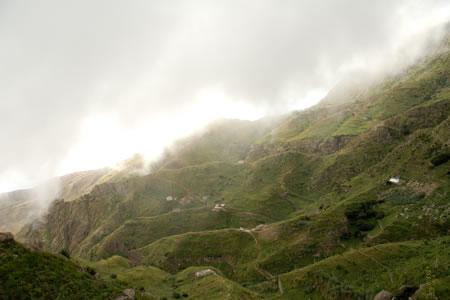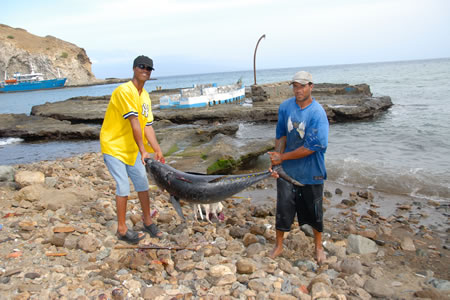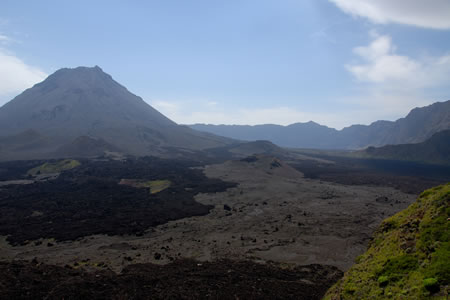English | Dutch |
|
| Brava & Fogo: Hiking paradises in Cape Verde | |
Mosteiros (Cape Verde), November 7th 2006 |
|
Despite the fact that Brava does not have real acknowledged highlights and is only reachable with a ferry, appears Brava a great island for hiking. Because its relative isolation, time seems to have been standing still. Therefore it feels like the “traditional” Cape Verde. Contrarily, Fogo has an absolute highlight in the form of the volcano Pico de Fogo. Fogo gives you the opportunity to get a close view on the remains of volcanic activity. Although Brava and Fogo are very different, in our opinion both deserve a visit of every hiker travelling to Cape Verde.
We started our journey in Praia, capital of Cape Verde, lying on the largest island Santiago. From Porto de Santiago, the ferry Barlavento leaves for its nightly 8 hour sea trip to Brava. Although you are sailing the Atlantic Ocean, the trip is perfectly doable, at least in good weather. After arriving at the harbour of Furna, we take an aluguer (Collective taxi) to Nova Sintra, capital city of Brava. |
|
 |
|
Brava is often covered by clouds |
|
| Not many tourists visit Brava because Brava cannot be reached by air due to fierce crosswinds. Moreover, only twice a week a ferry visits Brava. Therefore, lots of travellers leave Brava unvisited. This is one of the reasons that you can experience the more traditional live in Brava, without having to deal with children asking for money, pens or candy.
Brava is a small island (8 x 10 km), with a nice maze of 30 km of cobbled stone roads which make it possible to get quickly to the other side of the island. The island is lightly mountainous with beautiful bays and picturesque villages lying on the slopes connected by many paths. The hikes should not be taken too lightly. The paths are often steep and the existence of many different paths makes navigating difficult, making a good detailed hiking map essential. At the moment, detailed maps are difficult to obtain, especially in Cape Verde. (Within a few weeks you can download a small map with details of the hikes we made) There are various beautiful walks from Nova Sintra (520 metre) in the interior of the island to coastal places at sea level and back again. Because Nova Sintra is often lying in the clouds, it has a very mystic and serene atmosphere If you like hiking, Brava has enough possibilities to have an enjoyable stay of 3 to 6 days. Keep in mind that the length of your stay is also dependent on the sailing schedule of the Barlavento (you can leave Brava twice a week). Therefore we took the ferry to Fogo after 4 nice days in Brava. If the sea is quit, it is a nice trip of an hour, where you also have the chance to see dolphins. |
|
 |
|
Fishermen of Furna (Brava) are showing their catch of the day |
|
| Our main reasons to go to Fogo, are the immense hiking opportunities in the crater of the volcano Fogo and the great Fogo wine that is produced in valley of the craters (Chã das Caldeiras). The island of Fogo is one big volcano itself, and within the initial crater (that is still standing for 40%) there have been several volcanic eruptions for the last hundreds of years (most recently in 1951 and 1995). All those eruptions have left there own crater and lava fields. With hikes from the village of Portela you can see the marks of the volcanic activity from close by. Portela itself lies also within the initial crater and has the pousada/restaurant Pedra Brabo. This is a nice place to rest after some good hiking with great food and wine. This is also the place to meet the guides who can take you to the top of Pico de Fogo. The nearly perfect conic Pico de Fogo is the largest (2,829 metre) and most spectacular volcano in the Chã de Caldeiras. On the first day we decide the climb this volcano; a 1,200 metre ascent and descent. The climb takes around 3,5 hours while descending takes around 1,5 hours. The view from the top of the volcano is great. The lava fields below look like a kind of dark moon landscape, and you have a perfect view on the Chã das Caldeiras. When we were there, the clouds were hanging below the Chã de Caldeiras so it looked as if it was the edge of the world. After staying half an hour at the top of the Pico, it was time to start at the spectacular descent. This is the time to become a child again! Through the ash and gravel you can run down the slope as hard as you can. When the speed gets to high you can let yourself fall in the ash. When taking a highly needed shower afterwards, you will find ashes everywhere from your shoes to your hair even in your underwear. | |
 |
|
View on Chã das Caldeiras with Pico de Fogo as highlight |
|
| Within the Chã das Caldeiras you can also walk around the lava field of the eruption of 1995. This lava field covers a part of the valley as a blanket. Its also great to make hike to the top of the initial crater rim, from which you have a great view on the Chã das Caldeiras with the Pico de Fogo as great highlight. Moreover you will see the different lava fields with their different colours. The colour of the lava tells you from which eruption it has come.
On the third day we hiked with our full backpacks from Portela to Mosteiros. Poin-to-point its only 9 km, but the hike was demanding because the total descent was 1,600 metres. However, the hike was very beautiful and certainly worthwhile. It takes you through the national park Monte Velho, a small national park where the flora of this foggy forest is protected against the agricultural activities. Slowly you descent through the clouds and suddenly you get a nice view on the see and the small city of Mosteiros. You pass small villages and houses where people try to make a living by cultivating the steep, but fertile slopes of Fogo. From Mosteiros we went back to São Filipe where we thought back over the beautiful places we say in Brava en Fogo.
| |